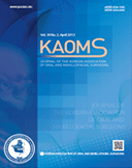Journal of the Korean Association of Oral and Maxillofacial Surgeons
- P-ISSN2234-7550
- E-ISSN2234-5930
- SCOPUS, KCI, ESCI
 ISSN : 2234-7550
ISSN : 2234-7550
Clinical factors affecting the outcome of arthocentesis
Altaf H. Malik (Government Dental College, Srinagar)
Ajaz A. Shah (Government Dental College, Srinagar)
Abstract
Objectives: This study aimed to evaluate the effect of clinical factors on the outcome of arthrocentesis in the treatment of temporomandibular joint (TMJ) internal derangement. Materials and Methods: Fifty patients with TMJ internal derangement underwent arthrocentesis using ringer’s lactate. The present study evaluated the contribution of the clinical variables of age, time since onset, visual analogue scale (VAS) pain level, and range of motion (ROM) on the outcomes of TMJ arthrocentesis: age (≤25 years, >25 and ≤40 years, >40 and ≤60 years), VAS pain level (≤5, >5 and ≤7, >7 and ≤10), and ROM (<25 and ≥25 mm). Odds ratios (ORs) were used to describe the proportional benefit of each variable the on successful outcome of arthrocentesis. For the OR to be clinically relevant or even clinically noticeable, we assumed that the OR would need to be larger than 2. Results: Mean preoperative pain score was 6.49±1.560 and at 6 months postoperative was 0.46±1.147 with an average decrease of pain score 6 (P<0.001). The mean preoperactive maximum mouth opening was 26.14±4.969 mm and mean maximum mouth opening at 6-month inerval was 38.92±3.392 mm. The mean increase in the mouth opening was a mean difference of 12.78 mm (P<0.001). Logistic regression showed that the maximum benefit occurred in patients aged <25 years (OR, 12.01; P=0.012), a VAS pain level of >7 (OR, 11.25; P=0.039), and a maximum vertical opening of <25 mm (OR, 7.70; P=0.038). Conclusion: Lavage of the superior joint space with ringer’s lactate resulted in significant reduction in pain and improvement in mouth opening. Patients with a greater inflammatory component and younger patients benefitted more from arthrocentesis. Evaluation of these clinical variables helped in predictive modelling, which may provide clinicians with the opportunity to identify “at-benefit” patients early and initiate specific treatment.
- keywords
- Temporomandibular joint, Internal derangement, Arthrocentesis
- Downloaded
- Viewed
- 0KCI Citations
- 0WOS Citations